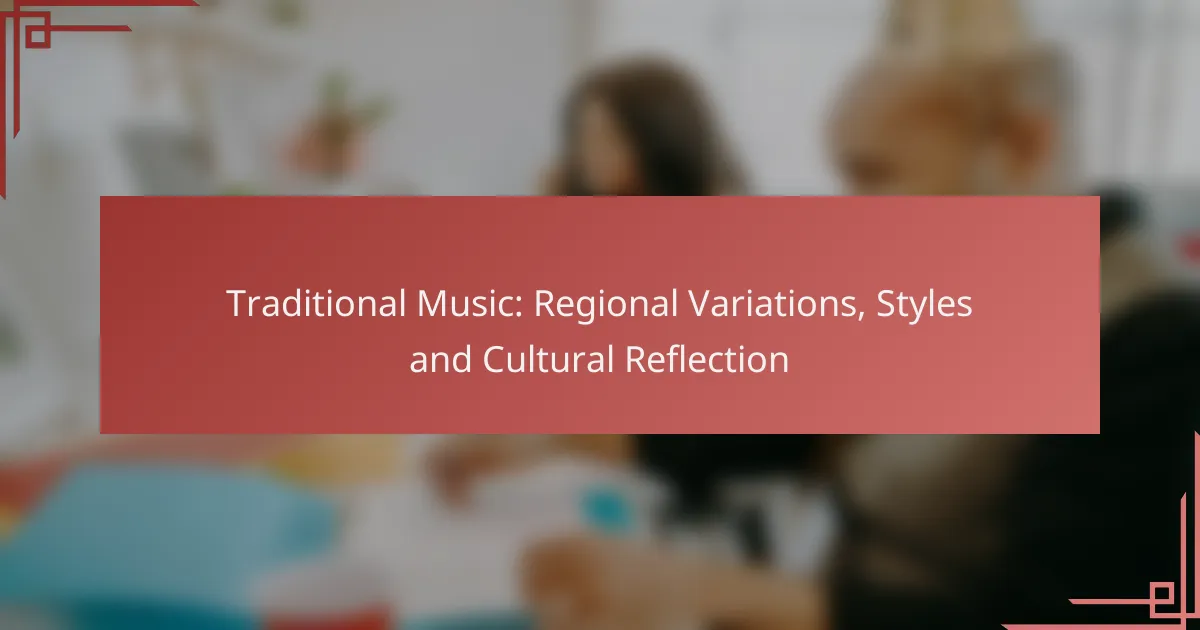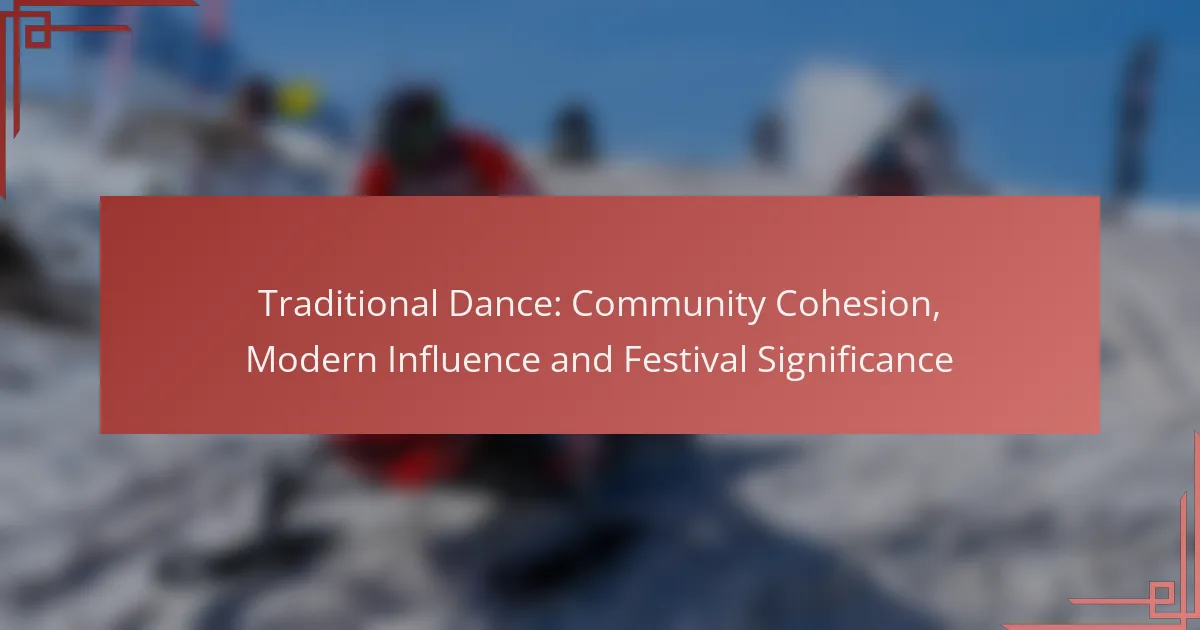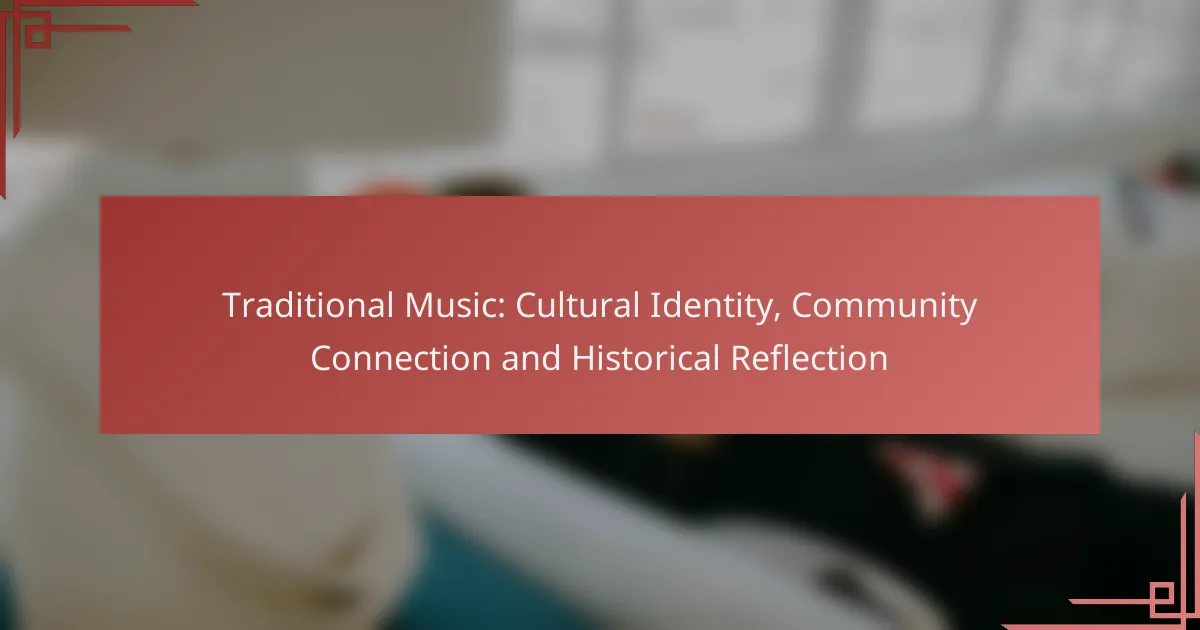Traditional music is a vibrant tapestry that varies across regions, shaped by the distinct cultural, historical, and social influences of each community. This music not only showcases unique instruments and singing styles but also serves as a profound expression of cultural identity, encapsulating the values and experiences of its people. From Bluegrass to Flamenco, each style reflects its own rich history and significance, fostering a sense of belonging and continuity among listeners.

What are the key regional variations in traditional music?
Traditional music varies significantly across regions, reflecting the unique cultural, historical, and social influences of each area. These variations can be seen in the instruments used, the styles of singing, and the themes of the songs.
Appalachian folk music
Appalachian folk music is characterized by its use of instruments like the banjo, fiddle, and guitar, often accompanied by vocal harmonies. This genre draws heavily from English, Irish, and Scottish musical traditions, showcasing storytelling through its lyrics.
Common themes include life in the mountains, love, and hardship, with songs often passed down through generations. Festivals and gatherings in the Appalachian region frequently feature live performances, preserving this rich musical heritage.
Andean music traditions
Andean music traditions encompass the diverse sounds of countries like Peru, Bolivia, and Ecuador, utilizing instruments such as the charango, pan flute, and bombo drum. The music often reflects the indigenous cultures and their connection to the Andean landscape.
Rhythms and melodies are typically vibrant and lively, often accompanying traditional dances during festivals. The use of local languages in lyrics adds to the cultural authenticity and richness of Andean music.
West African drumming
West African drumming is a fundamental aspect of the region’s musical identity, featuring complex rhythms and polyrhythmic structures. Instruments like the djembe, talking drum, and balafon are central to performances, which often serve communal and ceremonial purposes.
Drumming is not just music; it conveys messages and stories, with different rhythms symbolizing various events or emotions. Community gatherings frequently include drumming sessions, reinforcing social bonds and cultural traditions.
Indian classical music
Indian classical music is divided mainly into two traditions: Hindustani (North Indian) and Carnatic (South Indian). Each tradition has its own set of ragas (melodic frameworks) and talas (rhythmic cycles), which guide the improvisation and composition of music.
Performances often involve intricate vocal techniques and instrumental mastery, with a strong emphasis on emotional expression. Festivals and cultural events regularly feature classical music, highlighting its importance in Indian society.
Irish traditional music
Irish traditional music is known for its lively jigs and reels, often played on instruments like the fiddle, tin whistle, and bodhrán. This music is deeply rooted in the history and culture of Ireland, reflecting themes of joy, sorrow, and storytelling.
Sessions in pubs and community gatherings are common, where musicians come together to play and share tunes. The oral tradition of passing down songs ensures that Irish music remains vibrant and evolving, connecting generations through shared cultural experiences.

How does traditional music reflect cultural identity?
Traditional music serves as a powerful expression of cultural identity, encapsulating the values, beliefs, and experiences of a community. Through melodies, rhythms, and lyrics, it conveys the unique characteristics of a culture, fostering a sense of belonging and continuity among its members.
Storytelling through song
Traditional music often functions as a medium for storytelling, preserving narratives that define a culture’s heritage. Songs may recount historical events, legends, or moral lessons, allowing listeners to connect with their ancestry and shared experiences.
For example, in many Indigenous cultures, songs are used to pass down creation stories and significant events, ensuring that future generations remain aware of their roots. This oral tradition is vital for maintaining cultural continuity.
Rituals and celebrations
Music plays a crucial role in rituals and celebrations, marking important life events such as births, weddings, and funerals. These occasions often feature specific songs that enhance the emotional atmosphere and reinforce communal bonds.
In cultures around the world, traditional music is integral to festivals and ceremonies, such as the use of bagpipes in Scottish weddings or drumming in African tribal ceremonies. These musical elements help to create a shared identity and collective memory among participants.
Preservation of history
Traditional music acts as a historical archive, capturing the social and political contexts of its time. Through lyrics and styles, it reflects the struggles, triumphs, and everyday life of a community, preserving its history for future generations.
For instance, folk songs from various regions often address local issues, such as economic hardships or social injustices, providing insights into the historical landscape. This preservation is essential for understanding cultural evolution and resilience.
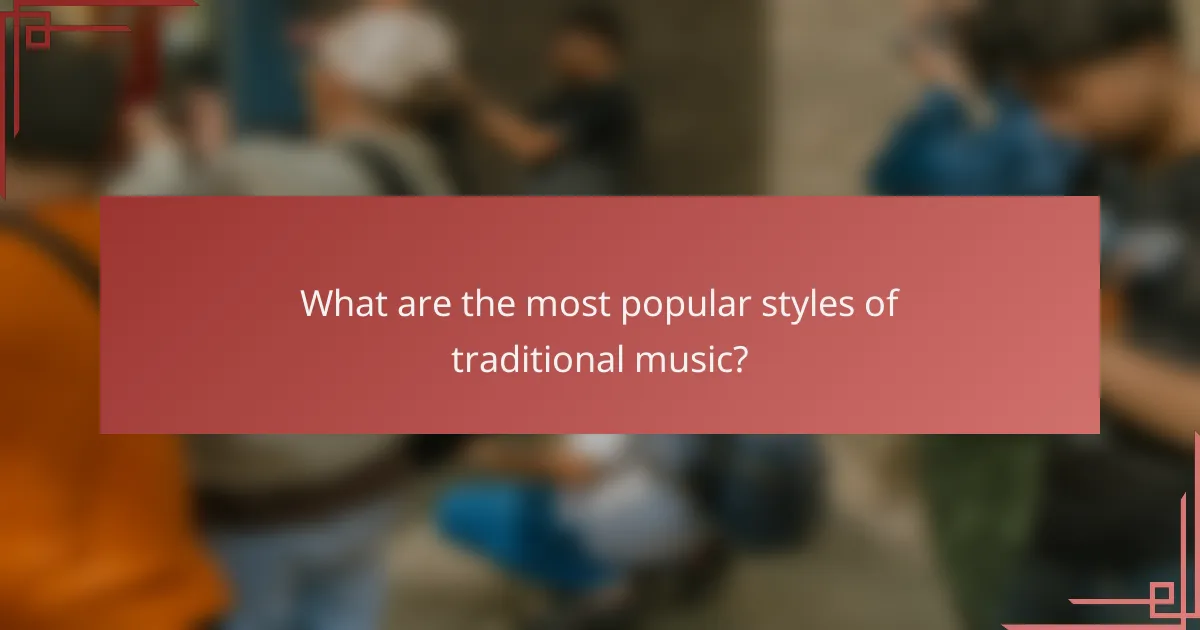
What are the most popular styles of traditional music?
The most popular styles of traditional music vary widely across cultures, each reflecting unique histories and social contexts. Key styles include Bluegrass, Flamenco, Gamelan, and Fado, each offering distinct sounds and cultural significance.
Bluegrass
Bluegrass music originated in the United States, blending elements of folk, country, and blues. Characterized by its use of acoustic instruments such as the banjo, mandolin, and fiddle, it often features high vocal harmonies and fast tempos.
When exploring Bluegrass, consider attending local festivals or jam sessions to experience the community aspect of this genre. Popular artists like Bill Monroe and the Stanley Brothers have shaped its evolution, making it a staple in American folk music.
Flamenco
Flamenco is a passionate music and dance form from the Andalusian region of Spain, known for its intricate guitar playing and expressive vocals. It combines elements of Gypsy, Moorish, and native Andalusian music, creating a rich tapestry of sound.
To appreciate Flamenco, look for performances that showcase its various styles, including cante (singing), toque (guitar playing), and baile (dance). Attending a live show in cities like Seville or Granada can provide an authentic experience of this vibrant tradition.
Gamelan
Gamelan is a traditional ensemble music of Indonesia, particularly associated with the islands of Java and Bali. It primarily features percussive instruments such as gongs, metallophones, and drums, creating complex rhythms and melodies.
Engaging with Gamelan music often involves participating in workshops or performances, where you can learn about its cultural significance and the communal aspect of playing together. The music is often performed at ceremonies and celebrations, highlighting its role in Indonesian culture.
Fado
Fado is a genre of Portuguese music characterized by its melancholic themes and expressive singing. It typically features a singer accompanied by a Portuguese guitar, conveying deep emotions related to longing and nostalgia.
To experience Fado, visit traditional Fado houses in Lisbon or Coimbra, where you can enjoy live performances. Understanding the themes of “saudade” (a deep emotional state of nostalgic longing) can enhance your appreciation of this soulful music style.

How do instruments vary across different traditional music styles?
Instruments in traditional music styles vary significantly based on cultural heritage, regional resources, and historical influences. Each instrument not only serves a musical purpose but also reflects the identity and values of the community it originates from.
Banjo in American folk
The banjo is a key instrument in American folk music, known for its bright, twangy sound. Originating from African roots, it has evolved through various styles, including bluegrass and old-time music, often featuring in lively gatherings and storytelling sessions.
Typically made with a circular body and a long neck, the banjo can be played in different tunings, allowing for a range of musical expressions. Its unique sound is often complemented by other instruments like the fiddle and guitar, creating a rich, layered musical experience.
Shamisen in Japanese music
The shamisen is a traditional Japanese stringed instrument that plays a central role in various genres, including folk, classical, and theatrical music. With its distinct three-string design and a body made from wood and animal skin, the shamisen produces a unique, resonant sound that is both melodic and percussive.
Different playing techniques, such as plucking and strumming, allow musicians to convey a wide array of emotions. The shamisen is often featured in cultural performances, including bunraku (puppet theater) and kabuki, highlighting its importance in Japanese artistic expression.
Bagpipes in Scottish music
Bagpipes are iconic in Scottish music, characterized by their distinctive drone sound and rich history. Traditionally made from animal skins and wood, bagpipes consist of a bag, chanter, and drones, allowing for continuous sound production while the player breathes.
Used in various settings, from military ceremonies to folk celebrations, bagpipes evoke a strong sense of national pride. They are often accompanied by drums and other instruments, creating a powerful and stirring musical atmosphere that resonates with audiences during festivals and parades.
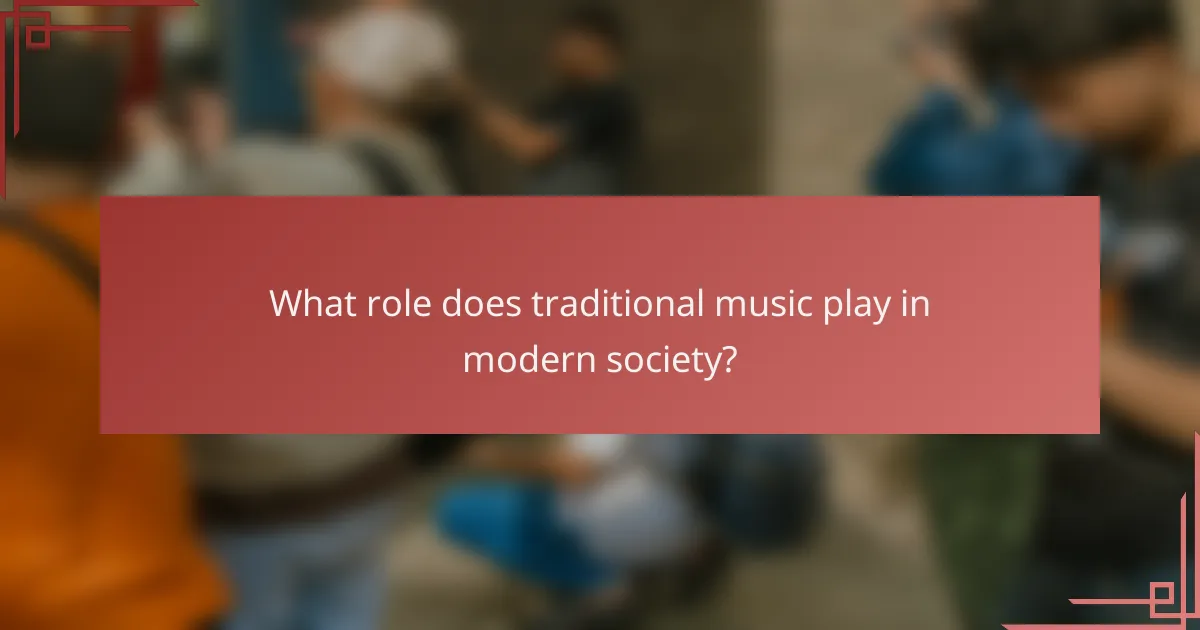
What role does traditional music play in modern society?
Traditional music serves as a cultural anchor in modern society, preserving heritage while influencing contemporary expressions. It fosters community identity and continuity, allowing people to connect with their roots and each other through shared musical experiences.
Influence on contemporary genres
Traditional music significantly shapes contemporary genres by infusing them with unique rhythms, melodies, and instrumentation. For example, elements of folk music can be found in pop, rock, and even electronic music, creating hybrid styles that resonate with diverse audiences.
Artists often sample traditional sounds or collaborate with folk musicians, bridging the gap between past and present. This fusion not only enriches the music but also introduces younger generations to their cultural heritage.
Revival movements
Revival movements aim to reinvigorate interest in traditional music, often in response to globalization and cultural homogenization. These movements can include festivals, workshops, and community gatherings that celebrate local musical traditions.
Such initiatives help to keep traditional music alive, ensuring that it remains relevant and accessible. They also encourage participation from younger musicians, who may reinterpret traditional styles in innovative ways.
Music education and heritage
Music education plays a crucial role in preserving traditional music by teaching it in schools and community programs. Through structured lessons and informal gatherings, students learn not only the techniques but also the cultural significance behind the music.
Integrating traditional music into educational curricula fosters appreciation for cultural diversity and encourages students to explore their own musical heritage. This approach can help maintain a vibrant musical landscape that honors the past while looking to the future.

What are the challenges facing traditional music today?
Traditional music faces several challenges today, including globalization, technological changes, and cultural homogenization. These factors can dilute regional styles and make it difficult for traditional music to thrive in a rapidly changing world.
Globalization and Cultural Homogenization
Globalization has led to the widespread sharing of music across borders, often overshadowing local traditions. As popular music genres dominate, traditional styles may struggle to maintain their unique identities and audiences.
Many communities find it challenging to preserve their musical heritage when influenced by global trends. This can result in a loss of distinct regional sounds and practices, as younger generations gravitate towards more mainstream music.
Technological Changes
Advancements in technology have transformed how music is created, distributed, and consumed. While this can provide new opportunities for exposure, it can also marginalize traditional music forms that rely on live performance and community engagement.
For instance, the rise of digital streaming platforms often favors popular music, making it harder for traditional artists to gain visibility. Musicians may need to adapt their methods of promotion and performance to reach wider audiences.
Funding and Support
Securing funding and support for traditional music initiatives can be difficult. Many traditional musicians rely on grants, sponsorships, or community support, which may be limited in the face of competing interests.
Organizations and governments can play a crucial role by providing resources and platforms for traditional music. However, without consistent funding, many artists may struggle to sustain their craft and share their cultural heritage.
